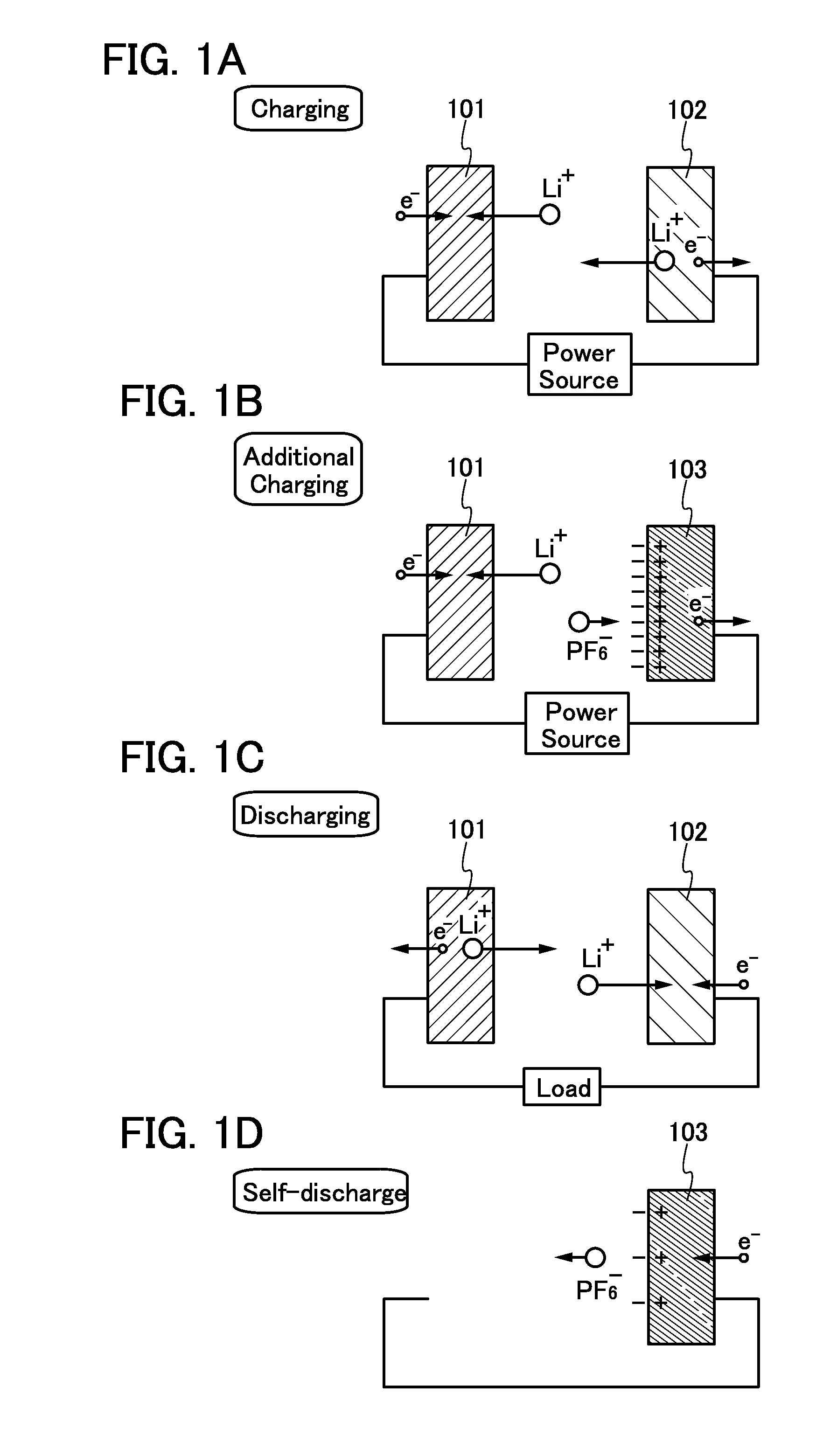Power storage device and method for charging the same
a technology of power storage device and charging method, which is applied in the direction of secondary cell servicing/maintenance, sustainable manufacturing/processing, secondary cell details, etc., can solve the problem of reducing the capacity of the power storage device, and achieve the effect of increasing the resistance of the positive electrode and inhibiting the decrease of the battery capacity
- Summary
- Abstract
- Description
- Claims
- Application Information
AI Technical Summary
Benefits of technology
Problems solved by technology
Method used
Image
Examples
embodiment 1
1.1. Method for Charging and Discharging Power Storage Device
[0065]As illustrated in FIG. 2A, a power storage device 100 includes at least a negative electrode 101, a positive electrode 102, and a third electrode 103. A separator 104 is provided to prevent the negative electrode 101, the positive electrode 102, and the third electrode 103 from being short-circuited with one another. A space 105 is filled with an electrolyte solution. Each of the electrodes is described in detail later.
[0066]A method for charging and discharging the power storage device 100 is described with reference to FIGS. 1A to 1D. Note that the separator is not illustrated in FIGS. 1A to 1D.
[0067]As illustrated in FIG. 1A, charging of the power storage device 100 is performed by connecting the negative electrode 101 and the positive electrode 102 of the power storage device 100 to a power source such as a system power supply. When the power storage device 100 is a lithium-ion secondary battery, a carrier ion (a...
embodiment 2
[0110]An example of the circuit 203 is described with reference to FIG. 6.
2.1. Circuit Configuration
[0111]The circuit 203 includes a processor 710, a bus bridge 711, a memory 712, a memory interface 713, a controller 720, an interrupt controller 721, an I / O interface (input-output interface) 722, and a power gate unit 730.
[0112]The circuit 203 further includes a crystal oscillation circuit 741, a timer circuit 745, an I / O interface 746, an I / O port 750, a comparator 751, an I / O interface 752, a bus line 761, a bus line 762, a bus line 763, and a data bus line 764. Furthermore, the circuit 203 includes at least connection terminals 770 to 776 as portions for connection to an external device. Note that each of the connection terminals 770 to 776 represents one terminal or a terminal group including a plurality of terminals. An oscillation unit 742 including a quartz crystal unit 743 is connected to the circuit 203 through the connection terminal 772 and the connectio...
embodiment 3
3. Power Storage Device
[0147]As an example of a power storage device, a nonaqueous secondary battery typified by a lithium-ion secondary battery is described.
3.1. Positive Electrode
[0148]First, a positive electrode of the power storage device is described with reference to FIGS. 7A and 7B.
[0149]A positive electrode 6000 includes a positive electrode current collector 6001 and a positive electrode active material layer 6002 formed over the positive electrode current collector 6001 by a coating method, a CVD method, a sputtering method, or the like, for example. Although an example of providing the positive electrode active material layer 6002 on both surfaces of the positive electrode current collector 6001 with a sheet shape (or a strip-like shape) is illustrated in FIG. 7A, one embodiment of the present invention is not limited to this example. The positive electrode active material layer 6002 may be provided on one of the surfaces of the positive electrode current collector 6001. ...
PUM
 Login to View More
Login to View More Abstract
Description
Claims
Application Information
 Login to View More
Login to View More - R&D
- Intellectual Property
- Life Sciences
- Materials
- Tech Scout
- Unparalleled Data Quality
- Higher Quality Content
- 60% Fewer Hallucinations
Browse by: Latest US Patents, China's latest patents, Technical Efficacy Thesaurus, Application Domain, Technology Topic, Popular Technical Reports.
© 2025 PatSnap. All rights reserved.Legal|Privacy policy|Modern Slavery Act Transparency Statement|Sitemap|About US| Contact US: help@patsnap.com



